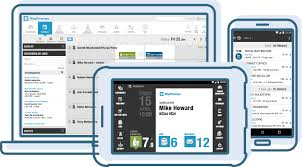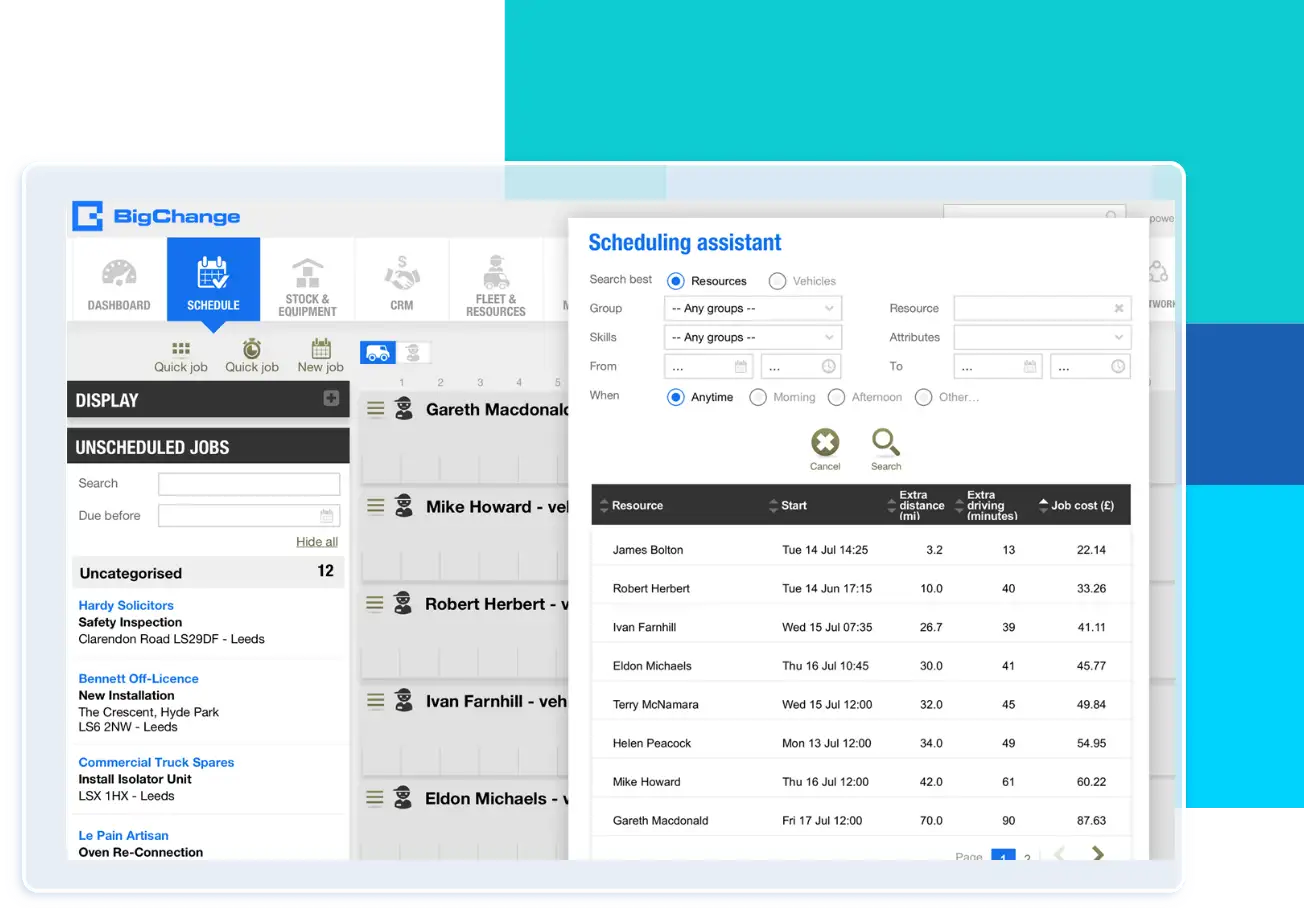Field service businesses, large and small, need efficient job management processes in place to survive and thrive in today’s market.
But for many field service businesses, the act of capturing, tracking, and managing jobs is tricky. To make matters worse, 52%1 are still using pen-and-paper manual processes at some point in their operation, leading to inaccuracies and confusion.
From enquiry to first-time fix, there are three key challenges:
- Tracking engineers, parts, and vehicles
- Scheduling the right engineer to the right job
- Reporting, analytics, and invoicing
One solution to solve all these problems? A job management solution tracks jobs, combines systems all in one place and coordinates people and parts – to get every job done first time.
So which tasks should job management software handle? What are the benefits of moving from manual to automated job management? And how can you improve job management in 2023? This guide covers exactly that.
In this guide, you’ll learn: (shortcuts) ✂️
- What is job management? (A recap)
- The top 5 job management challenges
- Moving from manual to automated job management
- 7 ways to improve job management
- Unstoppable field service businesses (case examples)
- How to use BigChange to make job management a breeze
- Choosing the right job management system
- Frequently asked questions
What is job management?
Job management (a.k.a. field service management) is a combination of job scheduling, planning, and project management techniques used by field service management businesses. Businesses that improve job management see growth boosted by 35%. (More on this later.)
Job management functions may include:
- Job tracking and scheduling
- Live vehicle tracking
- Resource planning
- CRM management
- Automated payment processing
- Business intelligence

The top 5 job management challenges
Now that we know what job management is, let’s look at the most pressing challenges field service businesses face today.
Actually, the same issues are plaguing most businesses:
- Staffing issues - 46%2 of businesses are struggling with a shortage of talent
- Supply chain blockers - One in three3 expect supply chain issues to remain until the end of summer 2023
- Rising costs
- Unnecessary admin and paperwork - 52%3 are behind and using manual processes like spreadsheets and physical job sheets
- Meeting customer demands - 89%4 of customers expect to see modern, on-demand technology applied to their technician scheduling
The good news is that it’s possible to overcome these challenges and successfully plan, track and manage your field service business with one simple solution: technology. For example, real-time tracking of technicians helps you:
- Optimise the field workforce - Booking more jobs in by location, sending the closest technician to emergencies, reducing fuel cost and travel time.
- Update customers - Keep the customer updated on arrival times.
- Track costs - Tools like BigChange make it easy to track costs in real-time. The platform can automatically feed costs and time into reports and invoices to make reporting and invoicing seamless.
📕 Ready to learn more? Read:5 job management challenges and how to overcome them
Moving from manual to automated job management
Accurate job management and scheduling is a must-have for field service businesses. Or else, you experience operational inefficiencies that just make things unprofitable, and most likely bad customer experiences.
Here’s why:
- Paperwork challenges – Very labour intensive, it can also get lost, there’s a delay between a job being completed and the back-office processing it (which has a knock-on impact on invoicing/scheduling etc).
- Invoicing delays – Manual invoicing can be slow, disorganised and negatively impact cash flow.
- Creates a competitive disadvantage – Those with quicker scheduling and smoother customer experiences are much more attractive options for customers.
If you’re not automating job management, you’re missing a trick. Because businesses that make the move can actually measure substantial growth. Like in this case study where JWH Tanks saw 35% growth after moving to digital and automated processes.
Take a look at this blog to see how automated field service businesses boost growth.
7 ways to improve job management in 2023
Soon, businesses that are continuing to use traditional job management techniques like T-cards, spreadsheets and whiteboards just won’t be able to compete.
Putting it bluntly, customers just don’t want long wait times, poor communications and a lack of information on when field service engineers will attend.
As technology evolves, so does the competitive edge of other businesses in your industry.
So how exactly are businesses using new solutions to improve job management?
Here are just a handful of ways:
- Routing engineers more efficiently - For example: ensuring engineers take the fastest and shortest route and sending the nearest resource to a specific location.
- Keeping on schedule - Customers expect you to value their time and like to be kept fully informed, and of course, for the right engineers and parts to be sent to their job.
- Leveraging real-time information - This breaks down the barrier between field service engineers and the back office. Images and documents can be sent through instantly.
- Optimising resource management - For example: fleet tracking. 96%1 of companies that use it report a positive return on investment six months after implementation.
- Improving time management - Scheduling tools can actually cut admin by 60-70%, allowing teams to focus on booking more jobs.
- Reducing manual work - Say goodbye to human-error and hello to automated job management, reports, certificates and more.
- Improving cash flow - Whether that’s through tighter control of stock, no more forgotten invoices, or preventative maintenance.
To sum up, digital job management solutions can have an immediate effect on your profitability, efficiency and customer service.
📕 Want to learn more? Read the full blog here: 7 ways to improve job management or you may also like 6 ideas for your 2023 job management approach
Unstoppable field service businesses (case examples)
Reading all about job management is all well and good, but who is really bossing it when it comes to job management?
Here are a handful of unstoppable field service businesses to look at – starting with a new one.
Forecourt construction firm DBS boosts productivity 20%
BigChange’s job management system has not only boosted DBS’ productivity by 20%, but the system has also improved customer service and cut admin time by half:
- Prior to BigChange, they relied on spreadsheets, paper files, and a large wall-mounted map. It was extremely time-consuming and left too much room for human error.
- They considered other systems before BigChange, but they were either too complicated or not fit for purpose.
- Since implementing BigChange, DBS engineers can respond to emergency call-outs while minimising disruption to planned works, and easily manage all back-office functions all in one place.
“BigChange has saved DBS time and money on every aspect of the business, and the support is outstanding.” Operations Director, DBS
JWH Tanks boost growth by 35%
JWH Tanks chose BigChange to help gain and maintain quality standards and to improve the management of their nationwide operations:
- JWH Tanks needed to reduce data duplication, minimise paperwork, and eliminate inefficient workflows.
- Using BigChange, they have slashed the time taken to produce vital documents for each job, using the benefit of real-time information sharing.
- Since implementing BigChange, the admin burden has also dramatically reduced, and management has better control over costs, all contributing to increased turnover.
“Since we went live with BigChange, around two years ago, we have increased our turnover by around 35%.” Operations Manager at JWH Tanks
Sapphire Utility Solutions boost productivity by 100%
Through using BigChange, Sapphire’s field engineers are now equipped with mobile devices for real-time reporting. It's also helping deliver client critical milestones, manage risk on street works liabilities and assure a right-first-time approach.
Here’s why they are rolling it out to other areas of the business:
- Significant reduction in administration, with efficiency gains in the back office and field, and they achieved a 100% rise in productivity.
- Real-time monitoring enables Sapphire to get ahead of potential roadblocks through constraints and alerts, to hit client critical milestones.
- As it’s easy to use, highly configurable and intuitive, it was quickly embraced by both field and back-office staff.
“By making sure teams are where they are needed, at the right time with all the information they need, BigChange has boosted morale and aided staff retention.” Director of IT at Sapphire Utility Solutions
How to use BigChange to make job management a breeze
At BigChange, it’s our mission to make our customers successful by accelerating growth and sustainability in our community. We’ve even won awards for it. To put this into perspective, here are five examples of how BigChange makes a big impact on field service businesses.
Example #1: Effortless scheduling: Intelligent scheduling allows customers and engineers to schedule jobs, send and receive automated messages, and see if resources are on schedule.
Take MEDLEC, for example: The electrical contractor boosted productivity by 40% thanks to engineers being able to self-allocate jobs.

Example #2: Paperless operations: With all your key information stored digitally, your team can access it from anywhere in an instant. The increased efficiency will mean you get more work done – with the same amount of people. It’s good for the planet too. 🌍
Because BigChange is an all-in-one cloud-based solution, you can link up with Sage 50, Xero and more. This was a game changer for heating firm, Celsius. The link between BigChange and Xero is seamless with no delays. They only have to enter data once - cutting admin time in half.
Example #3: Easy to use mobile app: BigChange’s mobile app reduces job time, improves first-time fix rates, and you can send jobs to field workers in real-time, allowing for urgent changes to happen instantly. Actually, everything you want your field workers to have can be made available on a customer-by-customer basis, from site maps to manuals, forms and worksheets.
In fact, BigChange is saving LDF customers time and money, evidenced by 86% of its business coming from repeat customers.

Example #4: Accurate job tracking: Accurate tracking means complete visibility of your field based teams, vehicles, and assets with real-time updates.
Knowing exactly where your field workers are at all times, means you can reroute them if necessary or divert them to pick-up van stock from the nearest supplier or colleague. You can also plan and reduce fuel costs with smart routing between jobs.
These efficiencies can translate into big profits.
Example #5: Robust CRM: With a CRM system built for field service businesses, you can improve customer satisfaction through instant communication. Customers can log into a customer portal, track job progress, leave feedback, and directly communicate with your business.
The real value of a CRM comes when it is integrated with your job management software. Before BigChange, Omnia Plumbing used a standalone diary system, separate accounting software, and no CRM – which meant countless phone calls and lots of wasted time. Since implementing BigChange, their customer interaction has vastly improved with automated ETAs and updates. And vehicle tracking means they never miss a job - literally saving tens of thousands every year.
Example #6: Strong network and partnership: At BigChange, we are huge advocates of a partnership approach. We even have an entire team dedicated to it.
The BigChange “Network” provides the ideal platform for collaboration between customers.
Example #7: Business intelligence: With ‘at-a-glance’ dashboards, you gain improved insight into your business. You can set-up KPIs and track job completion stages, financial reports with details on work in progress, and much more.
It’s so important that everybody, from engineers to back-office staff have access to the right information. Warmaway, use BigChange to make sure engineers know in advance what their day looks like and know they have the information they need to deal with each and every job.
Example #8 Vehicle tracking: Finally, What makes BigChange the best job management software for many clients is its integration with vehicle and job tracking. This allows vehicle locations to be displayed on a secure, web-based mapping system. This real-time tracking provides instant visibility of technicians, as well as traffic conditions – reducing customer wait times and travel costs and emissions.
📕 You can read more about how BigChange provides competitive advantage here.
Or if we have convinced you that job management software is the way forward, start here with a demo to see if BigChange could work for you.
Choosing the right job management system
The right solution will do more than manage and schedule jobs. It will streamline back-office processes to save you time, money, and headaches.
Choosing the right job management software can mean the difference between fitting in more jobs and happier customers… or the source of almost every problem.
To save yourself from that fate, be sure your chosen solution provides you with:
- Job scheduling: to get the right people to the right job every time
- Mobile app: for efficient, paperless job management
- Live tracking: of fleet and resources in real-time
- CRM: to win more work and get closer to customers
- Integrations: such as Xero and Sage 50 invoicing to get paid faster and boost profits
- Business intelligence: to learn more about your business, beat KPIs, and help your business grow.
Lastly, nothing can replace a business that values a partnership approach.
Ready to take your business to the next level? Put us to the test with a quick demo.
Or, if you still have burning questions, take a look at the top three frequently asked questions below.
Frequently Asked Questions
1. What is a job management operating system?
A job management operating system is a software programme that manages a field service business’s resources, such as job scheduling, job tracking, and customer relationship management.
2. What is job management in cloud computing?
A cloud-based job management solution connects your back office, mobile workforce, and customers in one centralised place. You can login to cloud job management software from anywhere and manage everything from quotes to jobs and invoicing.
3. What is the difference between job management and field service management?
In short, job management and field service management are basically the same thing. Field service management refers to jobs performed out in the field, as opposed to on company property. Field service businesses usually dispatch engineers to specific locations (typically a customer’s location) to lease, install, repair, or maintain equipment.
Sources:
1FinanceOnline, 2022
2Statista, 2022






